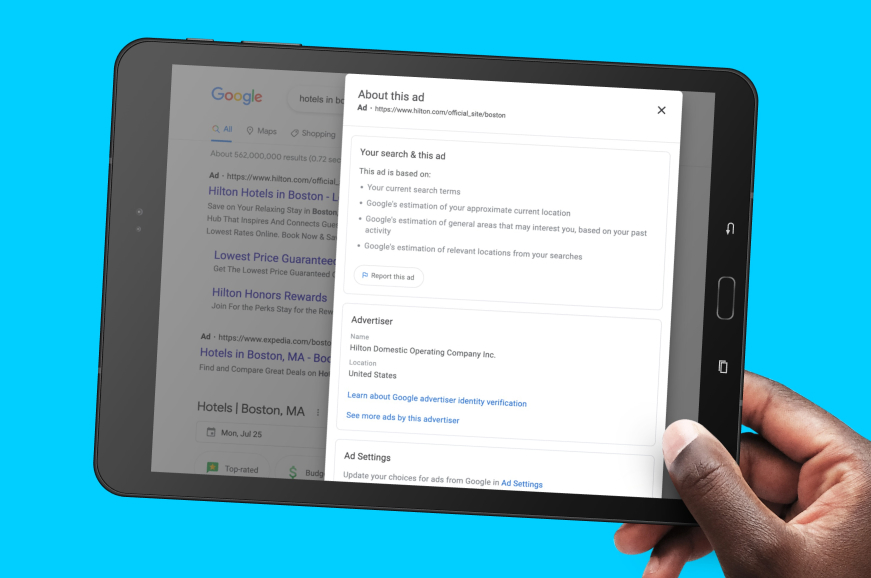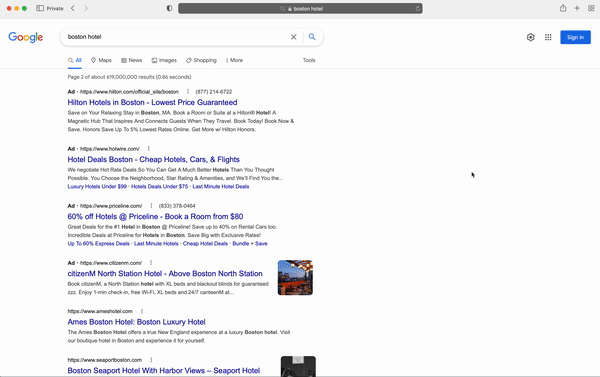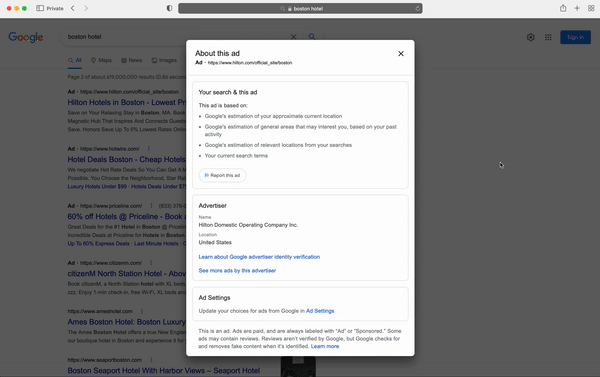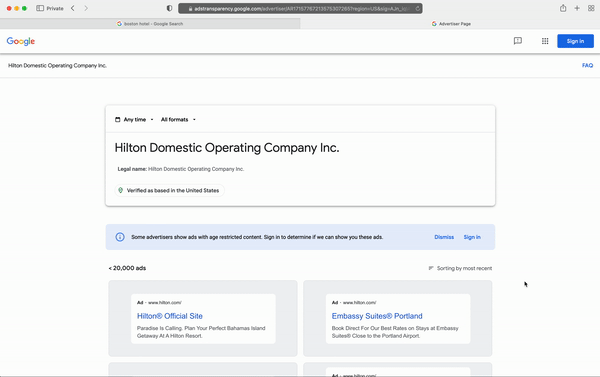How Google’s New Ad Transparency Can Give Your Hotel a Jump on the Competition

Competition in the hospitality industry is fierce. Every hotel, resort, inn, wedding and convention space is vying for guests. And nowhere is that competition more visible than in the battle over online revenue.
Property owners and managers are deploying all manner of online advertising strategies and campaigns in the hope of raising visibility and drawing visitors directly into their booking engine. Because the space is so competitive, gaining even the smallest insight can give you a leg up on your competition.
Google Ads recently rolled out a new “verified account” process that is being done in the spirit of providing more transparency to consumers. But that initiative is also providing some important (and previously unknown) information that could prove invaluable to those seeking an edge in the hospitality space.
Let’s take a moment to explore how this information can help you refine your marketing strategy, how it can be paired with other data sources to generate new online revenue and what you should be asking your agency partner about how they’re leveraging this resource.
Every Bit of Information Helps When Crafting an Online Advertising Strategy
In April 2020, Google introduced a new feature that allowed anyone on the internet to click on a series of dots next to an online advertisement to reveal who was behind it:
“As part of this initiative, advertisers will be required to complete a verification program in order to buy ads on our network. Advertisers will need to submit personal identification, business incorporation documents or other information that proves who they are and the country in which they operate.”
Ostensibly the tool was designed to provide more transparency for Google users. But it’s also an effective way to gauge how those in the hospitality industry are using Google campaigns to target potential customers.

Here’s what you can discover when you click on the three dots next to a Google ad or sponsored content:
- Why the ad is being displayed to you (terms from your search, your estimated location, estimated interests based on previous searches, relevant locations from previous searches).
- Who the verified advertiser is. It could be the property owner, its agency or a third-party like Expedia.
- The country where the advertiser is based.
- Access to other Google ads from this advertiser. This is an interesting rabbit hole to explore to see some of their other campaigns.
Is this the holy grail of marketing insights? Not exactly. Is it hacking, covert spying or corporate espionage? Of course not. This is information that is being freely given in a public forum. But it’s also information that was not previously disclosed, and becoming familiar with it now rather than later can give you a headstart on the competition.
Look at it like another arrow in your quiver. If you can combine this information with your additional marketing efforts and intelligence reporting, it might give you some nuggets here and there that you can use to craft a stronger strategy.
Does Your Partner Agency Know About Google’s New Feature?
Given the competitive nature of the hospitality industry, effective partner agencies are looking at opportunities from every possible angle to gain any advantage they can.
If your partner agency isn’t exploring how to use information from Google’s ad transparency feature, you should find out why. Is it something they plan to do in the future or will this responsibility fall to you?
Are they prepared to pair this information with other data sources to create a more complete view of what your competitor’s advertising strategies are? Do they know how to use SEO and keyword research, auditing and analytics tools like SEMRush, Moz and SpyFu? Using this additional information from Google will make those tools even more insightful.
At the bare minimum, you should be having a regular conversation with your agency partner about what can be gleaned from Google’s new ad transparency. See how they can begin incorporating that information into a regular, actionable report.
Google Ad Transparency Can Refine Your Marketing Messaging
Studying your competitors’ keyword usage is perhaps the biggest competitive edge you can gain with Google’s ad transparency feature. If you’re a luxury hotel in Boston, Google “luxury hotel, Boston” and see who else is advertising with those keywords. The results could surprise you.
For example, this feature could potentially uncover a competitor who was previously unknown to you. If you do some targeted keyword searches related to your property type and location and you’re getting hits for hotels that were not on your radar, you might need to reevaluate your own ad strategy.

Most hotel owners and managers regularly receive a STR report to provide insights on occupancy rates and daily room rates compared to your competitors. Within that report, you have to define a “comp set” or competitive set. Often that could be four hotels within the same block or neighborhood.
Your STR comp set is not the same as it is online. Your STR comp set is usually going to be similar brands, similar size, similar sets of amenities, similar locations.
When you go online, that’s not how it works at all. It’s not going to be those four or five properties in your neighborhood. It could be anybody. It could be a property in a different state. It could be an Airbnb.
Google’s ad transparency feature opens your eyes to competing entities that fall outside of your traditional STR comp set.
Practical Steps For Using New Google Ad Transparency Information
So you’ve identified a potential slate of new online competitors. What then?
That information could help you chart a different course in your online advertising approach. For example, you might consider increasing bids for keywords to try to outbid that group. It also might compel you to change your messaging.
Let’s say a newly discovered online competitor turns out to be an Airbnb that is touting a bunch of new, cool amenities at their property. Rather than trying to match their amenities, maybe you play up what you get at a hotel that doesn’t come with a home rental.

If you know what others are saying to chase customers in your same online space, you can tailor your messaging to compete with them. Having that information would allow you to make better use of your online advertising investment, helping to fine tune your overall strategy, bids, budgets and ad copy.
Get the Most Out of Google’s Transparency By Preparing Now
Google is still in the process of verifying its advertisers, so the full impact of its transparency initiative might not be felt for several more months. Having said that, it’s good for you and your agency partner to become familiar with this resource now.
If you want to know more about how O’Rourke can help you understand how Google’s ad transparency can help you boost business and get the most out of your online advertising budget, let’s talk.

